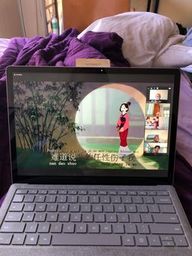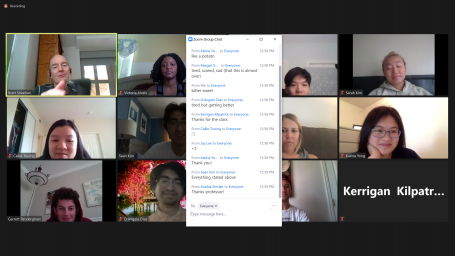Jay Lee & Victoria Alexis
Hello everyone, thank you for keeping up with our blog for the last two weeks! It’s a bittersweet moment to think that this week was our last zoom class meeting. From here on out, we will be meeting with our individual research groups and Professor Sheehan.
Our last few days of synchronous classes, however, were full of enriching discussion and preparation to really get started on our research projects. Following our last lecture on Chinese history on Tuesday, we read a piece about hybridization. One of the examples provided was the Disney film of the Mulan story, so we started off Wednesday’s class watching the Chinese dub of “Reflection.” Something interesting that Keegan mentioned in Wednesday’s class was that the song is not a direct translation of the English lyrics, but rather has its own lyrical identity, reflecting on how in hybridization, the blending of cultural aspects can create a new product as well.

Photo: A snapshot from our Classmate Sarah, for the beginning of Wednesday, May 29th class, started with a video from “Mulan.”
Professor Sheehan’s Wednesday lecture wrapped up our continuing discussion of China’s history, specifically its appearance on the global stage in the late twentieth century. The lesson spanned from China’s industrial rise to its modernization that led to its place in the world now. We learned how globalization helped mainland China gain presence in the global market, and using what we learned we can infer the different methods that Chinese companies use in relation to their culture and the world.
Following the lecture, we began a discussion on our readings on hybridization. By looking at the different facets of how culture manifests as different aspects of products, we added to our toolkit different approaches to looking at cultural products. The liger was used as an example of how two different entities can blend to produce an entirely separate entity with its own unique features. The Prius was used as an example of how one thing can have the features of two ideas.
We spent the next days of our remaining synchronous class time cementing our research projects. We worked in our groups and with Professor Sheehan to fine-tune the questions that would guide our research. In the TikTok research group, we looked at different primary sources and secondary sources that we thought may help us in our research on how Tik Tok’s marketing operates in the US.
While our current circumstances gave us a class very different than what we anticipated, everyone could agree that we gained a lot from Professor Sheehan’s efforts. Our research plans are much more solidified and we are all excited to do our work in the following week and present our findings to each other.

Photo: Some last final thoughts from our classmates about how they are feeling about the end of class.
Thanks again for reading! We are all excited about finishing and getting our results for our research questions. So be sure to tune back in and see what we concluded in our research!


